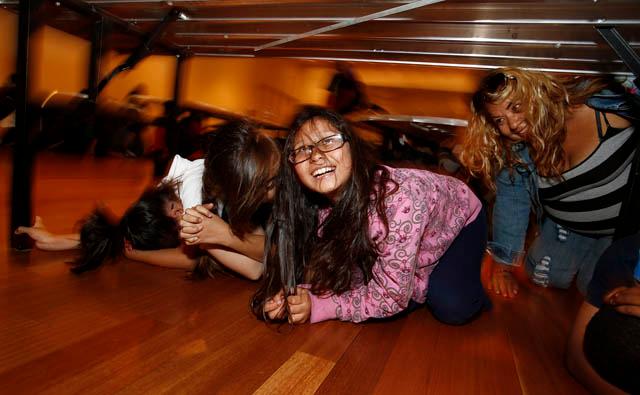
People all across the Bay Area will dive under desks on Thursday morning at 10:16 am to take cover.
That’s not a prediction of a major earthquake. Rather, it’s part of increasingly popular statewide and international earthquake preparedness event.
The Great California Shakeout is a 1-minute drill in which people at more than 9,000 schools, businesses, churches, hospitals and other facilities around the state — representing 10.3 million Californians so far — have signed to up stop what they are doing and pretend that a major earthquake is happening.
They will be told to “drop, cover and hold on” and will receive tips and other information about how to be safe when the next major earthquake occurs.
“It’s an important chance for everyone, everywhere, once a year to practice earthquake safety to learn what do and know what to do,” said Mark Benthien, director of public education at the Statewide California Earthquake Center at the University of Southern California.
Millions of people who have the My Shake app on their phones also will get an alert Thursday at 10:16 a.m. saying the system is being tested.
In the Bay Area, BART plans to automatically slow down its trains and have them come to a brief stop, as the system is programmed to do during significant earthquakes. Events will be held at Oakland City Hall, the Tech Museum of Innovation in San Jose, and other locations.
The overall event, which began in 2008 in Southern California as an emergency simulation of a 7.8 quake, is sponsored by the U.S. Geological Survey, the California Office of Emergency Services, and other organizations.
Cal OES officials have been visiting various locations around the state all week with their earthquake simulator, a trailer that has four seats and recreates the shaking of earthquakes up to 7.0 magnitude.
The simulator appeared Monday at the UC Davis campus, Tuesday at the San Francisco Zoo, Wednesday at Cal State Fullerton, and is scheduled to appear Thursday at the San Diego Waterfront.
“California is no stranger to disasters like earthquakes,” said Nancy Ward, Cal OES director, in a statement. “It’s important that we work with communities statewide to make sure they have the life-saving information they need to stay safe before the next seismic event.”
Benthien and other earthquake experts said if people are indoors during a quake, they should not run or stand in a doorway. Rather they should drop to their hands and knees, crawl under a sturdy desk or table, and hold on. If they are in bed, they should stay there and cover their head and neck with a pillow.
“It’s about making yourself a smaller target,” he said. “Get down on the ground before you are knocked down. Cover your head and neck. Most injuries come from falling and flying objects.”
If you are outdoors when a major quake happens, move to a clear and open area, and way from things that could fall, like buildings, power lines, and trees.
If you are in a vehicle experts recommend pulling over to the side of the road and staying in the vehicle until the shaking has stopped.
The last significant damaging earthquake in the Bay Area was the 6.0 South Napa Quake on Aug. 24, 2014, which killed 1 person, injured 300 and caused $1 billion in damage in Napa and Vallejo. That quake occurred on the West Napa Fault, a segment of the San Andreas Fault Zone.
Before that, it was the 6.9 magnitude Loma Prieta Earthquake on Oct. 17, 1989, which disrupted the World Series, and wrecked the Bay Bridge, Oakland’s Cypress Freeway, downtown Santa Cruz, and parts of San Francisco, killing 63 people and caused $6 billion in damages.
Millions of new people have moved into Northern California and been born since 1989, Benthien noted.
A bigger quake, like the 1906 earthquake in San Francisco, could cut power and water for days or weeks. Experts recommend storing an “earthquake kit” with at least three days of water, food and medicine in preparation.
“We have a lot of experience with magnitude 3, 4 and 5 quakes,” Benthien said. “But rarely anything above a 6. The shaking of even larger quakes is much more intense and lasts longer.”
There is about a 72% probability of one or more magnitude 6.7 or larger earthquakes occurring on any fault in the Bay Area, and 60% chance in Los Angeles, in the next 30 years the USGS has concluded.
For more information about the Thursday’s event, go to www.shakeout.org/california